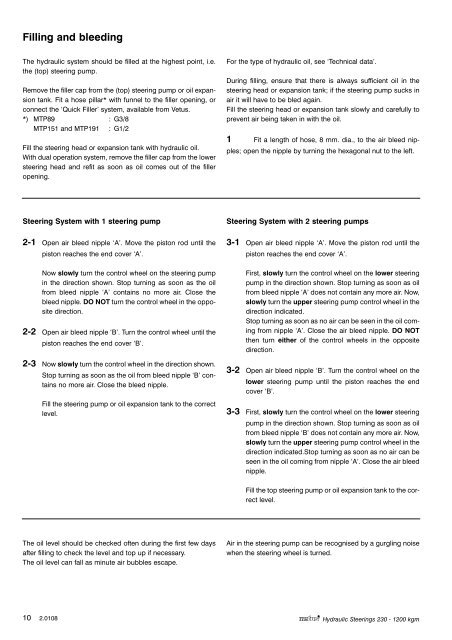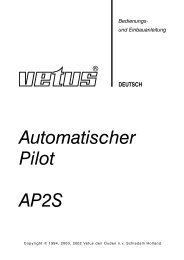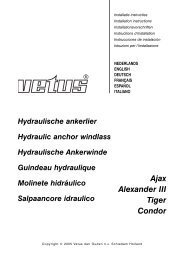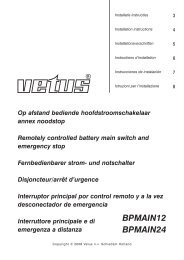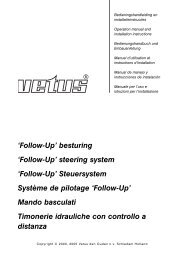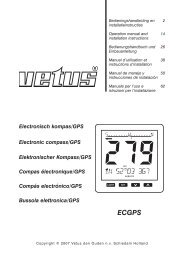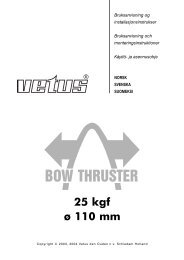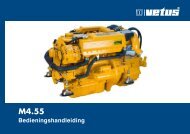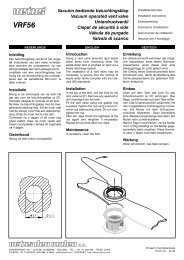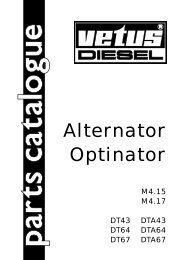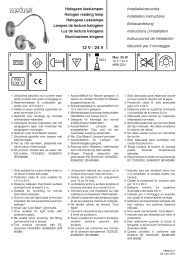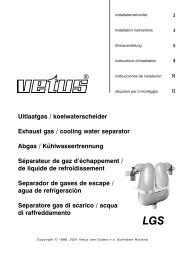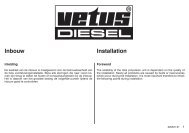1 2 - Vetus
1 2 - Vetus
1 2 - Vetus
You also want an ePaper? Increase the reach of your titles
YUMPU automatically turns print PDFs into web optimized ePapers that Google loves.
Filling and bleeding<br />
The hydraulic system should be filled at the highest point, i.e.<br />
the (top) steering pump.<br />
Remove the filler cap from the (top) steering pump or oil expansion<br />
tank. Fit a hose pillar* with funnel to the filler opening, or<br />
connect the ‘Quick Filler’ system, available from <strong>Vetus</strong>.<br />
*) MTP89 : G3/8<br />
MTP151 and MTP191 : G1/2<br />
Fill the steering head or expansion tank with hydraulic oil.<br />
With dual operation system, remove the filler cap from the lower<br />
steering head and refit as soon as oil comes out of the filler<br />
opening.<br />
Steering System with 1 steering pump<br />
2-1 Open air bleed nipple ‘A’. Move the piston rod until the<br />
piston reaches the end cover ‘A’.<br />
Now slowly turn the control wheel on the steering pump<br />
in the direction shown. Stop turning as soon as the oil<br />
from bleed nipple ‘A’ contains no more air. Close the<br />
bleed nipple. DO NOT turn the control wheel in the opposite<br />
direction.<br />
2-2 Open air bleed nipple ‘B’. Turn the control wheel until the<br />
piston reaches the end cover ‘B’.<br />
2-3 Now slowly turn the control wheel in the direction shown.<br />
Stop turning as soon as the oil from bleed nipple ‘B’ contains<br />
no more air. Close the bleed nipple.<br />
Fill the steering pump or oil expansion tank to the correct<br />
level.<br />
The oil level should be checked often during the first few days<br />
after filling to check the level and top up if necessary.<br />
The oil level can fall as minute air bubbles escape.<br />
For the type of hydraulic oil, see ‘Technical data’.<br />
During filling, ensure that there is always sufficient oil in the<br />
steering head or expansion tank; if the steering pump sucks in<br />
air it will have to be bled again.<br />
Fill the steering head or expansion tank slowly and carefully to<br />
prevent air being taken in with the oil.<br />
1 Fit a length of hose, 8 mm. dia., to the air bleed nipples;<br />
open the nipple by turning the hexagonal nut to the left.<br />
Steering System with 2 steering pumps<br />
3-1 Open air bleed nipple ‘A’. Move the piston rod until the<br />
piston reaches the end cover ‘A’.<br />
First, slowly turn the control wheel on the lower steering<br />
pump in the direction shown. Stop turning as soon as oil<br />
from bleed nipple ‘A’ does not contain any more air. Now,<br />
slowly turn the upper steering pump control wheel in the<br />
direction indicated.<br />
Stop turning as soon as no air can be seen in the oil coming<br />
from nipple ‘A’. Close the air bleed nipple. DO NOT<br />
then turn either of the control wheels in the opposite<br />
direction.<br />
3-2 Open air bleed nipple ‘B’. Turn the control wheel on the<br />
lower steering pump until the piston reaches the end<br />
cover ‘B’.<br />
3-3 First, slowly turn the control wheel on the lower steering<br />
pump in the direction shown. Stop turning as soon as oil<br />
from bleed nipple ‘B’ does not contain any more air. Now,<br />
slowly turn the upper steering pump control wheel in the<br />
direction indicated.Stop turning as soon as no air can be<br />
seen in the oil coming from nipple ‘A’. Close the air bleed<br />
nipple.<br />
Fill the top steering pump or oil expansion tank to the correct<br />
level.<br />
Air in the steering pump can be recognised by a gurgling noise<br />
when the steering wheel is turned.<br />
10 2.0108 Hydraulic Steerings 230 - 1200 kgm


